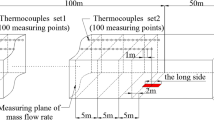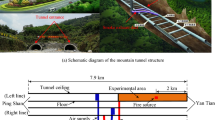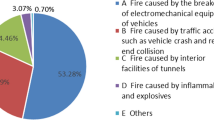Abstract
Wall restriction is an important factor affecting flame space development, air entrainment and heat transfer. To investigate the smoke characteristics in the one-dimensional horizontal spreading stage at different transverse fire locations in tunnel, FDS was used to simulate and analyze the smoke mass flow rate. The results show that the average smoke mass flow rate is positively correlated with distance from fire source to sidewall and heat release rate (HRR). The maximum smoke temperature rises decay exponentially along the longitudinal direction of the tunnel. Based on dimensional analysis, a prediction model is proposed to predict the average smoke mass flow rate in one-dimensional horizontal spreading stage in tunnel. For wall fires, predicted mass flow rate is 1.29 times of Zukoski model via generalizing the "mirror" effect. For non-wall fires, the dimensionless smoke mass flow is proportional to the 0.19 power of the dimensionless HRR. Besides, the reliability of the prediction model is verified by comparing with full-scale and reduced-scale experiments.








Similar content being viewed by others
Abbreviations
- T a :
-
The ambient temperature (K)
- T 0 :
-
Fire plume temperature at reference point (K)
- T x :
-
Fire plume temperature at x point (K)
- K :
-
Longitudinal decay coefficient of the ceiling excess temperature (m−1)
- B :
-
Contact length (m)
- D :
-
Diffusion coefficient (−)
- T 0 :
-
Smoke layer height (m)
- V*:
-
Dimensionless longitudinal ventilation rate (−)
- L :
-
Side length of fire source (m)
- d :
-
Distance between the fire and the sidewall (m)
- D*:
-
Characteristic fire diameter (m)
- H :
-
Tunnel height (m)
- W :
-
Tunnel width (m)
- Z :
-
Height from the fire source (m)
- \(\dot{m}_{p}\) :
-
Mass flow rate plume in open space (kg s−1)
- \({\bar{\dot{m}}}\) :
-
Average mass flow rate of plume in one-dimensional spreading stage (kg s−1)
- \({\bar{\dot{m}}}^{\ast}\) :
-
Dimensionless mass flow rate in one-dimensional spread stage ( −)
- \({{\dot{Q}}}\) :
-
Heat release rate (MW)
- \({{\dot{Q}}}_{d}^{\ast}\) :
-
Dimensionless heat release rate ( −)
- c p :
-
Constant pressure specific heat capacity of air (KJ (kg K)−1)
- T 0 :
-
Ambient temperature (K)
- g :
-
Gravity acceleration (m s−2)
- CFD:
-
Computational fluid dynamics
- FDS:
-
Fire dynamics simulator
- LES:
-
Large-eddy simulations
- HRR:
-
Heat release rate
- α :
-
Fire growth coefficient (–)
- ρ 0 :
-
Ambient density (kg m−3)
- δx :
-
Nominal size of a mesh cell (m)
- c :
-
Center side under the tunnel roof
- l :
-
Left side under the tunnel roof
- r :
-
Right side under the tunnel roof
References
Li HH, Liu JH, Ge JW (2020) Phenomenological characteristics of continuous spill fires in a tunnel with longitudinal ventilation. Process Saf Environ 138:108–116
Alarie Y (2002) Toxicity of fire smoke. Crit Rev Toxicol 32(4):259–289
Giebultowicz J, Ruzycka M, Wroczynski P, Purser DA, Stec AA (2017) Analysis of fire deaths in Poland and influence of smoke toxicity. Forensic Sci Int 277:77–87
Yao YZ, Wang R, Xia ZY, Ren F, Zhao JL, Zhu HQ, Cheng XD (2022) Numerical study of the characteristics of smoke spread in tunnel fires during construction and method for improvement of smoke control. Case Stud Therm Eng 34:102043
Lin CL, Chien CF (2021) Lessons learned from critical accidental fires in tunnels. Tunn Undergr Space Technol 113:103944
Alpert RL (1972) Calculation of response time of ceiling-mounted fire detectors. Fire Technol 8(3):181–195
Gao Y, Zhu G, Gu S, Tao H, Zhao Y (2018) Experimental and numerical studies on ceiling maximum smoke temperature and longitudinal decay in a horseshoe shaped tunnel fire. Case Stud Therm Eng 12:134–142
Li YZ, Ingason H (2014) Position of maximum ceiling temperature in a tunnel fire. Fire Technol 50(4):889–905
Lu K, Xia K, Shi C, Yang M, Wang J, Ding Y (2021) Investigation on the tunnel curvature effect upon the ceiling temperature of tunnel fires: a numerical simulation. Fire Technol 57(6):2839–2858
Gannouni S, BenMaad R (2016) Numerical analysis of smoke dispersion against the wind in a tunnel fire. J Wind Eng Ind Aerodyn 158:61–68
Feng X, Jiang Z, Zhang G, Luo X, Zeng F (2022) Study on CO diffusion law and concentration distribution function under ventilation after blasting in high-altitude tunnel. J Wind Eng Ind Aerodyn 220:104871
Chang X, Chai J, Luo J, Qin Y, Xu Z, Cao J (2020) Tunnel ventilation during construction and diffusion of hazardous gases studied by numerical simulations. Build Environ 177:106902
Wang J, Kong X, Fan Y, Jiang X, Lu K (2022) Reduced pressure effects on smoke temperature, CO concentration and smoke extraction in tunnel fires with longitudinal ventilation and vertical shaft. Case Stud Therm Eng 37:102311
Yang X, Luo Y, Li Z, Guo H, Zhang Y (2021) Experimental investigation on the smoke back-layering length in a branched tunnel fire considering different longitudinal ventilations and fire locations. Case Stud Therm Eng 28:101497
Huang Y, Li Y, Li J, Wu K, Li H, Zhu K, Li J (2022) Experimental investigation of the thermal back-layering length in a branched tunnel fire under longitudinal ventilation. Int J Therm Sci 173:107415
Li Q, Kang J, Wu Y, Luo J (2022) Theoretical and numerical study of smoke back-layering length for an inclined tunnel under longitudinal ventilation. Fire Technol 58:2143–2166
Zhang S, Yang H, Yao Y, Zhu K, Zhou Y, Shi L, Cheng X (2017) Numerical investigation of back-layering length and critical velocity in curved subway tunnels with different turning radius. Fire Technol 53(5):1765–1793
Newman JS (1984) Experimental evaluation of fire-induced stratification. Combust Flame 57(1):33–39
Li L, Tang F, Dong M, Tao C (2016) Effect of ceiling extraction system on the smoke thermal stratification in the longitudinal ventilation tunnel. Appl Therm Eng 109:312–317
Tang F, Li L, Dong M, Wang Q, Mei F, Hu L (2017) Characterization of buoyant flow stratification behaviors by Richardson (Froude) number in a tunnel fire with complex combination of longitudinal ventilation and ceiling extraction. Appl Therm Eng 110:1021–1028
Guo Y, Yuan Z, Yuan Y, Cao X, Zhao P (2021) Numerical simulation of smoke stratification in tunnel fires under longitudinal velocities. Underground Space 6(2):163–172
Khattri SK, Log T, Kraaijeveld A (2021) A novel representation of the critical ventilation velocity for mitigating tunnel fires. Tunn Undergr Space Technol 112:103853
Tang Y, Yin L (2020) Numerical studies on the critical velocity in bending tunnel. Case Stud Therm Eng 19:100579
Zhu Z, Guo Q, Quiel SE, Naito CJ (2022) Rapid prediction of fire-induced heat flux on the liners of horseshoe and circular tunnels with longitudinal ventilation at critical velocity. Fire Saf J 130:103590
Hong Y, Fu C (2022) A full-range analytical solution of the critical velocity for smoke control in tunnel fires. Case Stud Therm Eng 40:102531
Morton BR (1965) Modeling fire plume. In: 10th Symposium (International) on combustion, vol 10(1), pp 973–982
Zukoski TKEE (1981) B Cetegen Entrainment in fire plumes. Fire Saf J 3(3):107–121
Heskestad G (1984) Engineering relations for fire plumes. Fire Saf J 7(1):25–32
McCaffrey BJ (1979) Purely buoyant diffusion flames: some experimental results. National Bureau of Standards, Washington, NBSIR 79-1910
Hu L, Huo R, Chow WK, Wang H, Yang R (2004) Decay of buoyant smoke layer temperature along the longitudinal direction in tunnel fires. J Appl Fire Sci 13(1):53–77
Xu Z, Liu Q, He L, Tao H, Zhao J, Chen H, Li L, Fan C (2019) Study on the heat exhaust coefficient and smoke flow characteristics under lateral smoke exhaust in tunnel fires. Fire Mater 43(7):857–867
Ji J, Guo FY, Gao ZH, Zhu JP (2018) Effects of ambient pressure on transport characteristics of thermal-driven smoke flow in a tunnel. Int J Therm Sci 125:210–217
Li LJ, Du F, Yang YY, Wei LW, Huang F, Gao ZH, Song YW (2022) Research on the smoke mass flow rate in one-dimensional spreading stage in tunnel with multiple fire sources. Case Stud Therm Eng 31:101801
Guo Q, Li YZ, Ingason H, Yan Z, Zhu H (2021) Theoretical and numerical study on mass flow rates of smoke exhausted from short vertical shafts in naturally ventilated urban road tunnel fires. Tunn Undergr Space Technol 111:103782
Wang J, Fang Z, Tang Z, Yuan J (2021) Influence of longitudinal ventilation on the mass flow rate distribution of fire smoke flow in tunnels. Tunn Undergr Space Technol 112:103938
Zhong W, Li Z, Wang T, Liang T, Liu Z (2015) Experimental study on the influence of different. Fire Technol 51(5):1217–1230
Tang F, Hu P, He Q, Zhang JP, Wen J (2021) Effect of sidewall on the flame extension characteristics beneath a ceiling induced by carriage fire in a channel. Combust Flame 223:202–215
Zhong W, Li Z, Wang T, Liang T, Liu Z (2015) Experimental study on the influence of different transverse fire locations on the critical longitudinal ventilation velocity in tunnel fires. Fire Technol 51(5):1217–1230
Zukoski E (1995) Properties of fire plumes. In: Combustion fundamentals of fire. Academic Press, New York, pp 101–219
Li Y, Huo R, Yi L, Shi C (2004) The zone and numerical simulation on the tunnel fire. Chin Eng Sci 2(6)
Hu L, Huo R, Wang H, Li Y, Yang R (2007) Experimental studies on fire-induced buoyant smoke temperature distribution along tunnel ceiling. Build Environ 42(11):3905–3915
Delichatsios MA (1981) The flow of fire gases under a beamed ceiling. Combust Flame 43:1–10
Tang F, Li LJ, Chen WK, Tao CF, Zhan Z (2017) Studies on ceiling maximum thermal smoke temperature and longitudinal decay in a tunnel fire with different transverse gas burner locations. Appl Therm Eng 110:1674–1681
Oka Y, Oka H (2016) Velocity and temperature attenuation of a ceiling-jet along a horizontal tunnel with a flat ceiling and natural ventilation. Tunn Undergr Space Technol 56:79–89
Tang F, Hu LH, Yang LZ, Qiu ZW, Zhang XC (2014) Longitudinal distributions of CO concentration and temperature in buoyant tunnel fire smoke flow in a reduced pressure atmosphere with lower air entrainment at high altitude. Int J Heat Mass Transf 75:130–134
Fan CG, Ji J, Gao ZH, Sun JH (2013) Experimental study on transverse smoke temperature distribution in road tunnel fires. Tunn Undergr Sp Tech 37:89–95
Zhao SZ (2019) Study on smoke movement under longitudinal ventilation in tunnel fires. Chongqing University, Chongqing, pp 91–99
Heselden A, Hinkley P (1970) Smoke travel in shopping malls experiments in co-operation with Glasgow fire brigade-Part 1. Fire Research Station Note No. 832
Zhang SG (2017) Effect of subway train on the characteristics of back-flowed smoke in longitudinal ventilated subway tunnel. University of Science and Technology of China, Anhui, pp 27–43
Chen LF, Hu LH, Zhang XL, Zhang XZ, Zhang XC, Yang LZ (2015) Thermal buoyant smoke back-layering flow length in a longitudinal ventilated tunnel with ceiling extraction at difference distance from heat source. Appl Therm Eng 78:129–135
Chow WK, Gao Y, Zhao J, Dang J, Chow CL, Miao L (2015) Smoke movement in tilted tunnel fires with longitudinal ventilation. Fire Saf J 75:14–22
Hu LH, Huo R, Chow WK (2008) Studies on buoyancy-driven back-layering flow in tunnel fires. Exp Therm Fluid Sci 32(8):1468–1483
Zhang TH, Wang GY, Li JD, Huang YD, Zhu K, Wu K (2021) Experimental study of back-layering length and critical velocity in longitudinally ventilated tunnel fire with various rectangular cross-sections. Fire Saf J 126:103483
Hu LH, Tang F, Yang D, Liu S, Huo R (2010) Longitudinal distributions of CO concentration and difference with temperature field in a tunnel fire smoke flow. Int J Heat Mass Transf 53(13–14):2844–2855
McGrattan K, Hostikka S, McDermott R, Floyd J, Weinschenk C, Overholt K (2013) Fire dynamics simulator technical reference guide volume 1: mathematical model, 1018(1), 175. NIST Special Publication, Gaithersburg
Ji J, Gao ZH, Fan CG, Sun JH (2013) Large Eddy Simulation of stack effect on natural smoke exhausting effect in urban road tunnel fires. Int J Heat Mass Transf 66:531–542
Tomar MS, Khurana S, Chowdhury S (2022) A numerical method for studying the effect of calcium silicate lining on road tunnel fires. Therm Sci Eng Prog 29:101245
Hurley MJ, Gottuk DT, Hall JR Jr, Harada K, Kuligowski ED, Puchovsky M, Watts JM Jr, Wieczorek CJ (2015) SFPE handbook of fire protection engineering. Springer, New York
Caliendo C, Ciambelli P, De Guglielmo ML, Meo MG, Russo P (2013) Simulation of fire scenarios due to different vehicle types with and without traffic in a bi-directional road tunnel. Tunn Undergr Space Technol 37:22–36
NFPA 502 (2017) Standard for road tunnels, bridges, and other limited access highways. National Fire Protection Association, Quincy
McGrattan K, Hostikka S, McDermott R, Floyd J, Weinschenk C, Overholt K (2013) Fire dynamics simulator user’s guide. NIST Spec Publ 1019(6):1–339
He YP (1999) Smoke temperature and velocity decays along corridors. Fire Saf 33(1):71–74
Gao ZH, Ji J, Fan CG, Sun JH, Zhu JP (2014) Influence of sidewall restriction on the maximum ceiling gas temperature of buoyancy-driven thermal flow. Energ Buildings 84:13–20
Gao ZH, Liu ZX, Ji J, Fan CG, Li LJ, Sun JH (2016) Experimental study of tunnel sidewall effect on flame characteristics and air entrainment factor of methanol pool fires. Appl Therm Eng 102:1314–1319
Delichatsios MA (1981) The flow of fire gases under a beamed ceiling. Conbust Flame 43(4):1–10
Kunsch JP (1998) Critical velocity and range of a fire-gas plume in a ventilated tunnel. Atmos Environ 33(1):13–24
Jiang XP, Liu MJ, Wang J, Li KY (2016) Study on air entrainment coefficient of one-dimensional horizontal movement stage of tunnel fire smoke in top central exhaust. Tunn Undergr Space Technol 60:1–9
Acknowledgements
Financial support for the work presented was provided by the National Natural Science Foundation of China (Project Nos. 51904120), whose supports are greatly appreciated.
Author information
Authors and Affiliations
Corresponding authors
Ethics declarations
Competing interests
The authors declare that they have no known competing financial interests or personal relationships that could have appeared to influence the work reported in this paper.
Additional information
Publisher's Note
Springer Nature remains neutral with regard to jurisdictional claims in published maps and institutional affiliations.
Rights and permissions
Springer Nature or its licensor (e.g. a society or other partner) holds exclusive rights to this article under a publishing agreement with the author(s) or other rightsholder(s); author self-archiving of the accepted manuscript version of this article is solely governed by the terms of such publishing agreement and applicable law.
About this article
Cite this article
Chen, R., Guo, Z., Liu, Y. et al. Numerical Study of the Effect of Different Transverse Fire Locations on Smoke Mass Flow Rate in Tunnel Fires. Fire Technol 59, 2567–2586 (2023). https://doi.org/10.1007/s10694-023-01442-3
Received:
Accepted:
Published:
Issue Date:
DOI: https://doi.org/10.1007/s10694-023-01442-3




